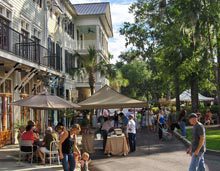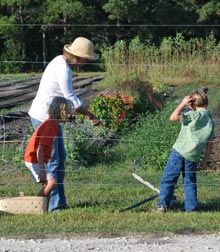Is there a correlation between the Slow Food Movement and people’s general concern about the loss of quality of life associated with rampant development that threatens the character of their community? The Slow Food Movement started in Europe as a reaction to the onslaught of American fast food chains opening in historic towns and cities. These chains disrupted the tradition of restaurants and cafés that worked within a local and regional network of farm to market to table.
In the past fifteen years the popularity of the Slow Food Movement has greatly expanded internationally, with local Slow Food “Convivia”—small local chapters—established all over the world. The Snail is their symbol “of slow motion, to educate us that being fast makes man inconsiderate and foolish.”
The Slow Food Manifesto states:
“We are enslaved by speed and have all succumbed to the same insidious virus: Fast Life, which disrupts our habits, pervades the privacy of our homes and forces us to eat Fast Foods. In the name of productivity, Fast Life has changed our way of being and threatens our environment and our landscapes. So Slow Food is now the only truly progressive answer.”
If a convivium is spawned to encourage the slow pleasure of eating, could a like movement envelope other quality-of-life issues? In Italy, a network of “Slow Cities” Has already been formed. In regions of the U.S., where Smart Growth, or New Urban, principles have been embraced, there is still growing interest in slowing down rampant growth.
So what would Beaufort County’s development be like if the current zoning ordinance and planning policy was modified using elements of the Slow Food treatise and transforming some its guiding principles into a slowed-down version of New Urbanism—say Slow Urbanism?
A Slow Urbanism Treatise might sound something like this:
“Slow Urbanism encourages people to create whole neighborhoods; to celebrate local community building traditions; and to take time—this is the important (and fun part) – to enjoy community life with family and friends.”
Our motto will be “Make Haste Slowly.”
We’ll start Slow Urbanism Conviviums (or Clubs for the less pretentious) composed of distinguished citizens, architects, landscape architects, town planners, builders, interior designers, artists, gardeners, house designers, shop owners, musicians, environmentalists, Realtors, marketing people, restaurateurs, and municipal officials, politicians, and (even) developers. Most importantly, the conviviums will include just plain folk.
We’ll meet on weekends in various neighborhoods—or future sites for neighborhoods—for “Slow Urbanism Socials.”
We’ll form a subcommittee for eco-urbanists and proclaim, “You can’t have ecology without urbanism and you can’t have urbanism without ecology!” And that “in order to grow a community well, you need authentic local sustainable models based on tradition.”
We’ll support local trades and suppliers. In Slow Urbanism the small scale builders and designers will be the heroes. Unlike mass production development, Slow Urbanism development will create places with a fine-grain and mixed variety. Building neighborhoods using traditional, low-tech methods—putting local building traditions at center stage.
Our Slow Urbanism Convivium will take field trips to visit great towns and neighborhoods for intellectual study and to have some fun away from the sprawl zones.
Our meetings will be held over a pleasurable meal and drinks, in a grouping of rocking chairs, in neighborhood cafes, coffee houses, parks, front porches, and squares.
During meetings, we’ll take leisurely strolls along pedestrian friendly streets and get to know our neighbors. There won’t be any Jack-in-the-Boxes, Friday’s, Old Navy’s, or Wal-Marts glaring at us across parking lots.
Slow Urbanism will be for real people who want to live in meaningful neighborhoods. What better way to make a political statement than by living in a well-designed and well-built supportive neighborhood?
A neighborhood gathering of the Slow Urbanism Convivium would seem a world away from suburban sprawl zones and the boomtown pile-ups. It’s possible some people might even experience community life for the first time.
Slow Urbanism will be the antithesis to new urbanism on steroids. It could be real joy! Nurturing authentic and meaningful community as the core idea of the Slow Urbanism mission will make the movement appealing to everyone.
Anyone interested in joining? I’ll be the first to sign up!
Tom Low practices architecture and town planning in the Carolinas—slowly but surely.








